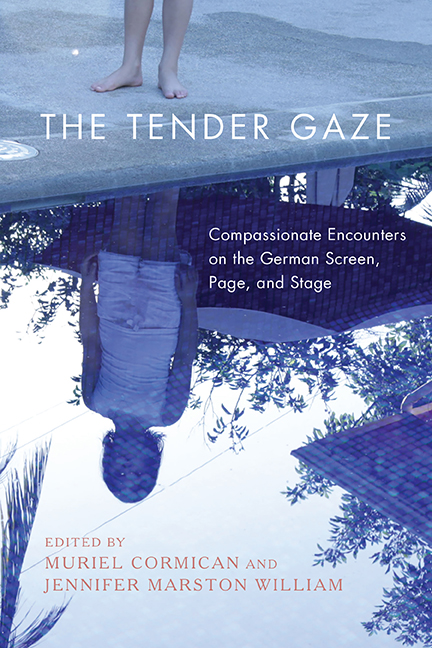Book contents
- Frontmatter
- Contents
- Acknowledgments
- Introduction: The Tender Gaze
- 1 Toward a Theory of the Tender Gaze: Affect, Critical Insight, and Empathy in Contemporary German Cinema
- 2 The Tender Gaze, Embodied Politics, and Perspective-Taking in German Postdramatic Theater
- 3 Face to Face: Race, Gender, and the Gaze in Mo Asumang’s Die Arier
- 4 “Risse, hinter denen man einen Kern entdeckt, der so ähnlich ist wie die Herzen von uns allen”: The Tender Gaze in Umut Dağ’s Risse im Beton
- 5 Looking through the Eyes of Empathy: Encouraging a Culture of Caring and Compassion in Doris Dörrie’s Keiner liebt mich
- 6 The Tender and Transgressive Beast Within: Escape Narratives in Films by Krebitz, Stuber, and Speckenbach
- 7 Looking at Looking in Margarethe von Trotta’s Das Versprechen
- 8 A Queer Phenomenology of Gender in Maren Ade’s Alle Anderen and Toni Erdmann
- 9 Rilke’s “Schauen”
- 10 Pity Stares or Tender Gaze? Seeing Disability in Nineteenth-Century Austrian and German Literature
- 11 The Sociohistorical and Gendered Implications of Gazing Tenderly in Ludwig Tieck’s “Liebeszauber”
- 12 Mothering, Animals, and the Surveillance State in the Anthropocene: An Ecofeminist Reading of Birgit Vanderbeke’s Die Frau mit dem Hund
- Notes on the Contributors
- Index
4 - “Risse, hinter denen man einen Kern entdeckt, der so ähnlich ist wie die Herzen von uns allen”: The Tender Gaze in Umut Dağ’s Risse im Beton
Published online by Cambridge University Press: 05 October 2022
- Frontmatter
- Contents
- Acknowledgments
- Introduction: The Tender Gaze
- 1 Toward a Theory of the Tender Gaze: Affect, Critical Insight, and Empathy in Contemporary German Cinema
- 2 The Tender Gaze, Embodied Politics, and Perspective-Taking in German Postdramatic Theater
- 3 Face to Face: Race, Gender, and the Gaze in Mo Asumang’s Die Arier
- 4 “Risse, hinter denen man einen Kern entdeckt, der so ähnlich ist wie die Herzen von uns allen”: The Tender Gaze in Umut Dağ’s Risse im Beton
- 5 Looking through the Eyes of Empathy: Encouraging a Culture of Caring and Compassion in Doris Dörrie’s Keiner liebt mich
- 6 The Tender and Transgressive Beast Within: Escape Narratives in Films by Krebitz, Stuber, and Speckenbach
- 7 Looking at Looking in Margarethe von Trotta’s Das Versprechen
- 8 A Queer Phenomenology of Gender in Maren Ade’s Alle Anderen and Toni Erdmann
- 9 Rilke’s “Schauen”
- 10 Pity Stares or Tender Gaze? Seeing Disability in Nineteenth-Century Austrian and German Literature
- 11 The Sociohistorical and Gendered Implications of Gazing Tenderly in Ludwig Tieck’s “Liebeszauber”
- 12 Mothering, Animals, and the Surveillance State in the Anthropocene: An Ecofeminist Reading of Birgit Vanderbeke’s Die Frau mit dem Hund
- Notes on the Contributors
- Index
Summary
UMUT DAǦ'S SECOND FILM, Risse im Beton (Cracks in Concrete, 2014) is set among small-time criminals in a largely second-generation migrant environment in Vienna. The title's reference to breaking a rough, hard surface has to do with a father's attempt, after ten years in prison, to connect with the son who has never met him, a son poised to repeat his father's mistakes. While not abandoning the unflinching social realism prevailing in Austrian art cinema since the mid-1990s, Risse decidedly appeals to the viewer's affective response, especially with its protagonist. Describing actor Murathan Muslu's portrayal, one reviewer claims, “the way Muslu plays his character's reactions rings so true it's hard not to feel for the man.” Through a figurative cracking of the cinematic mean streets the father inhabits, Risse illustrates what Muriel Cormican calls the tender gaze. After elaborating the concept of the tender gaze and introducing Dağ's work, I will examine how the film elicits a tender gaze from the viewer. Isolating how Risse privileges acts of looking and being seen elucidates the tender gaze and offers insights into the protagonist's depiction of the father's return to society and to his son, which registers the director's sensitivities to the representation of characters with a migration background.
Cormican's conception of a tender gaze offers a qualification to, among other things, the notion of cinema's inherent “male gaze” as elaborated by Laura Mulvey. Mainstream film, Mulvey argues, positions the spectator to assume the male hero's gaze, which is structured around the control and objectification of the female figure as spectacle for the male gaze. A tender gaze upon a character, as Cormican defines it, undermines the gendered structuring of power, eroticization, and objectification and offers a compassionate perspective that appeals to viewers’ recognition of a shared human condition. A further hallmark of a tender gaze resides in the extended temporal dimensions and complexity of narrative contextualization. Through the richer portrayal of the spaces and situations characters inhabit, the tender gaze penetrates beyond the spectacle of a surface image to enable the viewer's deeper reading of a figure, one that draws on the viewer's intellectual and emotional facilities.
- Type
- Chapter
- Information
- The Tender GazeCompassionate Encounters on the German Screen, Page, and Stage, pp. 76 - 89Publisher: Boydell & BrewerPrint publication year: 2021



